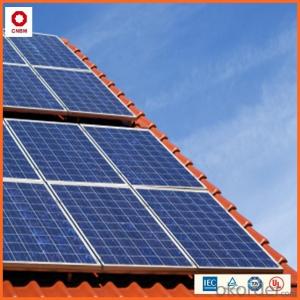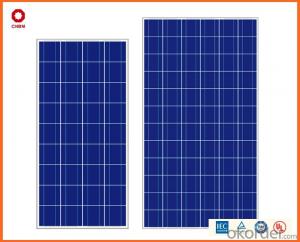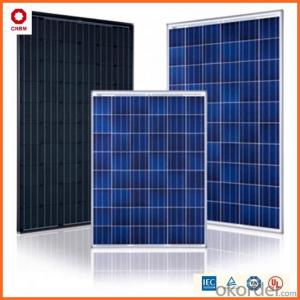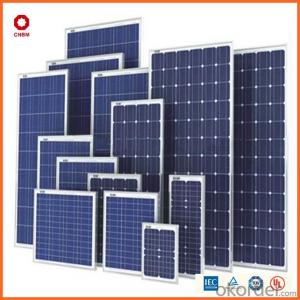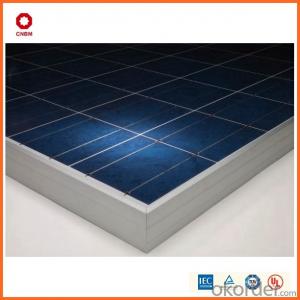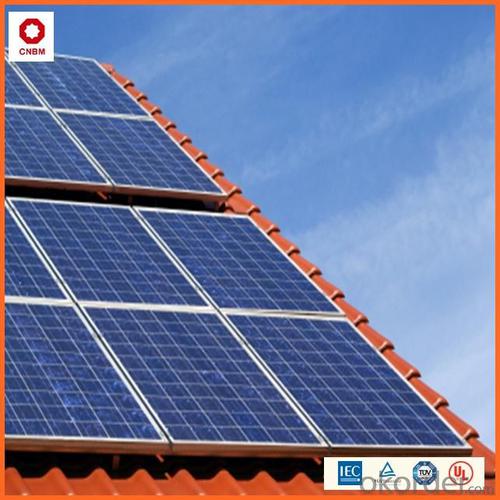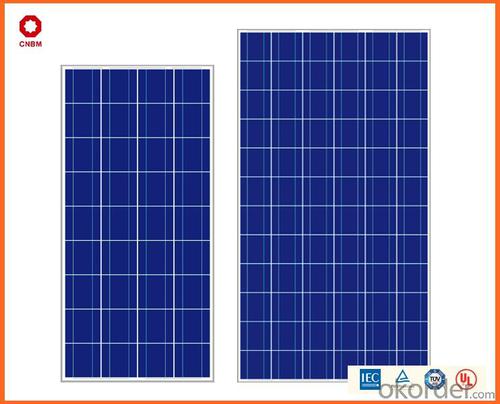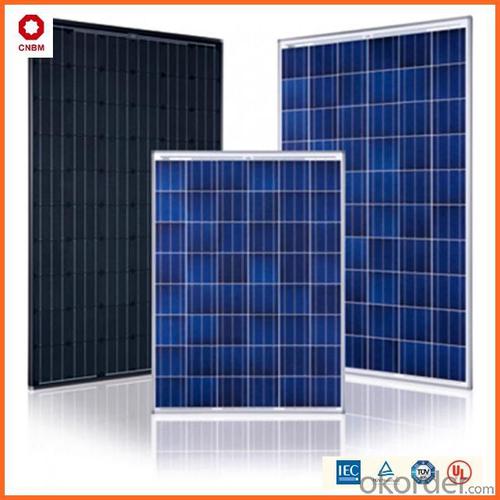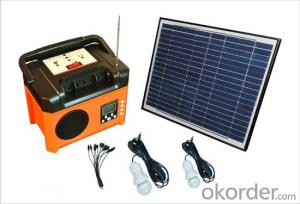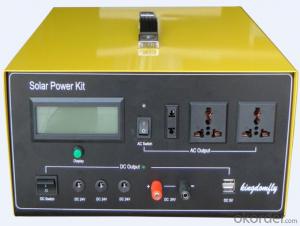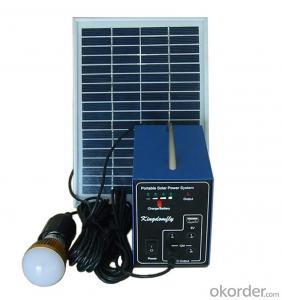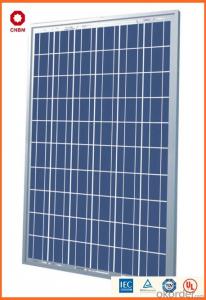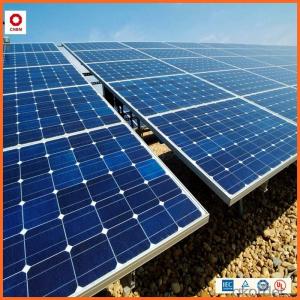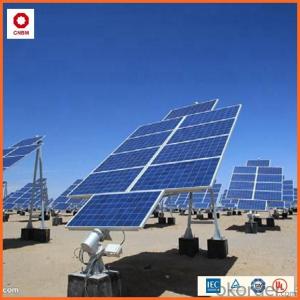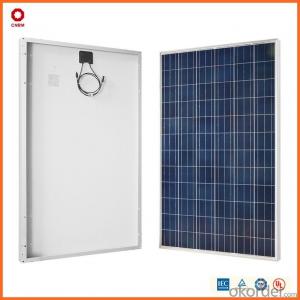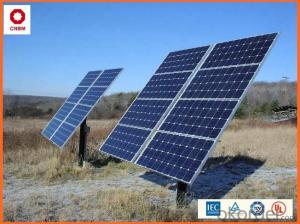Solair Solar Energy Systems - !!! Hot on Sale!!! Stock 260W Poly Solar Panel USD0.45/W A Grade Good Solar Panel
- Loading Port:
- China main port
- Payment Terms:
- TT OR LC
- Min Order Qty:
- 1 watt
- Supply Capability:
- 10000000 watt/month
OKorder Service Pledge
OKorder Financial Service
You Might Also Like
Product Description:
Hot Sale !!! Quality and Safety of 245w-320w Poly Solar Panel
1. Rigorous quality control meets the highest international standards.
2. High-transmissivity low-iron tempered glass, strong aluminium frame.
3. Using UV-resistant silicon.
4. IS09001/14001/CE/TUV/UL
Warranties of 245w-320w Poly Solar Panel
1. 10 years limited product warranty
2. 15 years at 90% of the minimal rated power output
3. 25 years at 80% of the minimal rated power output
Technical date of 245w-320w Poly Solar Panel
ITEM NO.: | Mono 125*125 cell ,36pcs . Power range from 80Wp-100Wp | ||||||||
Maximum Power(W) | 80 | 85 | 90 | 95 | 100 | ||||
Optimum Power Voltage(Vmp) | 17.81 | 17.89 | 17.94 | 17.99 | 18.06 | ||||
Optimum Operatige Current(Imp) | 4.78 | 4.91 | 5.12 | 5.35 | 5.59 | ||||
Open Circuit Voltage(Voc) | 21.98 | 22.05 | 22.14 | 22.28 | 22.45 | ||||
Short Circuit Current(Isc) | 4.95 | 5.15 | 5.36 | 5.65 | 5.84 | ||||
Solar Cell: | 125*125 Mono | ||||||||
Number of Cell(pcs) | 4*9 | ||||||||
Brand Name of Solar Cells | JA Cell, Bluesun Cell | ||||||||
Size of Module(mm) | 1580*808*35 | ||||||||
Caple & Connector Type | Pass the TUV Certificate | ||||||||
Frame(Material Corners,etc.) | Aluminium-alloy | ||||||||
Backing (Brand Type) | TPT | ||||||||
Cell Efficiency for 100W(%) | 15.8% | ||||||||
Weight Per Piece(KG) | 12.0KG | ||||||||
FF (%) | 70-76% | ||||||||
Junction Box Type | Pass the TUV Certificate | ||||||||
Tolerance Wattage(e.g.+/-5%) | ±3%, or 0-3% | ||||||||
Front Glass Thikness(mm) | 3.2 | ||||||||
Temperature Coefficients of Isc(%) | +0.04 | ||||||||
Temperature Coefficients of Voc(%) | -0.38 | ||||||||
Temperature Coefficients of Pm(%) | -0.47 | ||||||||
Temperature Coefficients of Im(%) | +0.04 | ||||||||
Temperature Coefficients of Vm(%) | -0.38 | ||||||||
Temperature Range | -40°C to +85°C | ||||||||
Surface Maximum Load Capacity | 2400Pa | ||||||||
Allowable Hail Load | 23m/s ,7.53g | ||||||||
Bypass Diode Rating(A) | 12 | ||||||||
Warranty | 90% of 10 years,80% of 25 years. | ||||||||
Standard Test Conditions | AM1.5 1000W/ 25 +/-2°C | ||||||||
Packing | carton or pallet | ||||||||
1*20' | 25 Pallets / 450pcs | ||||||||
1*40'STD | 25 Pallets / 100pcs | ||||||||
Features of our products:
• High conversion efficiency mono/poly-crystalline amorphous silicon solar cells
• Modules incorporate high performance bypass diodes to minimize the power drop caused by shading
• High transmittance, low-iron tempered glass
• High performance EVA encapsulant to prevent destroying and water.
• AI frame: without screw, corner connection. 8 holes on the frame can be installed easily
• Good performance of preventing from atrocious weather such as wind and hails
• Certifications: CE IEC TUV VDE UL, Class I
• 10 years 90% power output warranty

Shipping of 245w-320w Poly Solar Panel
By Sea | Delivery from Shanghai or Ningbo seaport |
By Air | Departure from Shanghai Pudong Airport |
By Express | Post by DHL, EMS, UPS, TNT. |
- Q: How does the angle of solar panels affect their efficiency?
- The angle of solar panels significantly affects their efficiency. The optimal angle is generally determined by the geographical location and time of year. If the angle is too steep, the panels may not receive enough sunlight, leading to reduced efficiency. Similarly, if the angle is too shallow, the panels may not capture sunlight effectively. Therefore, adjusting the angle of solar panels to maximize sunlight exposure is crucial for optimizing their efficiency.
- Q: What is the role of solar energy systems in reducing energy inequalities?
- Solar energy systems play a crucial role in reducing energy inequalities by providing access to clean and affordable energy for communities that are marginalized or lack access to traditional energy sources. By harnessing the power of the sun, these systems can be installed in remote or underserved areas, bringing electricity to those who need it the most. Solar energy also helps in reducing reliance on fossil fuels, which are often more expensive and contribute to environmental degradation. By promoting energy independence and sustainability, solar energy systems help bridge the gap between energy haves and have-nots, ensuring a more equitable distribution of resources.
- Q: What is the role of solar batteries in storing excess solar energy?
- The role of solar batteries in storing excess solar energy is to capture and store the surplus energy produced by solar panels during periods of high production, such as sunny days. These batteries store the excess energy for later use, allowing households and businesses to have a reliable source of electricity during times when solar production is low or non-existent, such as at night or during cloudy days. By storing the excess energy, solar batteries help increase energy self-sufficiency, reduce reliance on the grid, and promote renewable energy utilization.
- Q: Can solar energy systems be used for street lighting?
- Yes, solar energy systems can be used for street lighting. Solar street lights are becoming increasingly popular as they are more energy-efficient, cost-effective, and environmentally friendly compared to traditional street lights. They rely on solar panels to convert sunlight into electricity, which is then stored in batteries and used to power the street lights during the night. This renewable energy solution reduces reliance on the grid and helps to reduce carbon emissions.
- Q: Can a solar energy system be installed in a coastal area?
- Yes, a solar energy system can be installed in a coastal area. In fact, coastal areas can be ideal for solar installations due to the abundance of sunshine and the potential for strong winds, which can help keep the solar panels cool and increase their efficiency. However, it's important to consider the potential impact of saltwater corrosion on the system's components and to use appropriate materials and maintenance practices to ensure its longevity.
- Q: Can solar energy systems be used for emergency response operations?
- Yes, solar energy systems can be used for emergency response operations. Solar power provides a reliable and sustainable source of energy that can be used to power essential equipment and infrastructure during emergencies. It can be used to charge batteries, run communication systems, provide lighting, and power medical equipment in remote or disaster-stricken areas where there may be limited access to electricity. Solar energy systems are versatile, easy to deploy, and can help ensure the continuity of critical services during emergency situations.
- Q: How can solar energy systems reduce electricity bills?
- Generating free and renewable energy from the sun, solar energy systems have the potential to significantly decrease electricity bills. Unlike conventional electricity sources like fossil fuels, solar energy doesn't necessitate ongoing expenses for fuel or maintenance. Once installed, a solar energy system can produce electricity for many years, offsetting a substantial portion of a household's or business's electricity usage. By utilizing the power of the sun, solar energy systems can generate electricity when it is most in demand during daylight hours. Consequently, solar energy can directly compensate for electricity consumption during peak times, diminishing the need to draw power from the grid. Consequently, electricity bills can be drastically reduced or even eliminated, depending on the size and efficiency of the solar energy system. Furthermore, solar energy systems often provide homeowners and businesses with the opportunity to take advantage of numerous financial incentives and programs. These incentives may include tax credits, grants, or policies such as net metering, which allows surplus solar energy to be fed back into the grid and credited towards future electricity bills. These incentives can augment the financial advantages of installing solar energy systems, making them even more cost-effective. Additionally, solar energy systems offer long-term savings. As the cost of electricity from conventional sources continues to escalate, solar energy remains a steadfast and predictable investment. By securing a fixed cost for electricity generation, solar energy systems safeguard against future price hikes and inflation, ensuring that electricity bills remain low and foreseeable for years to come. Overall, solar energy systems provide a sustainable and economically viable solution for reducing electricity bills. By tapping into the abundant and free energy of the sun, households and businesses can enjoy substantial savings, financial incentives, and long-term stability in their energy costs.
- Q: How does a solar energy system connect to the electrical grid?
- A solar energy system connects to the electrical grid through a process called net metering. Net metering allows solar energy system owners to receive credits for the excess electricity they generate and feed back into the grid. The solar panels in a solar energy system convert sunlight into direct current (DC) electricity. This DC electricity is then sent to an inverter, which converts it into alternating current (AC) electricity that is compatible with the electrical grid. The AC electricity is then sent to the main electrical panel of the building or residence, where it can be used to power the electrical appliances and devices within the premises. If the solar energy system generates more electricity than is needed at a particular time, the excess electricity is sent back to the grid through a bi-directional meter. The bi-directional meter measures both the electricity consumed from the grid and the excess electricity sent back to the grid. The excess electricity is credited to the solar energy system owner's account, effectively spinning the meter backward. These credits can be used to offset the electricity consumed from the grid during times when the solar panels are not generating enough electricity, such as at night or during cloudy days. By connecting to the electrical grid, a solar energy system ensures a reliable and continuous supply of electricity. It also allows the system owner to benefit financially by reducing their electricity bills and potentially earning income through the excess electricity sent back to the grid.
- Q: Can solar energy systems be used in areas with high levels of vandalism or theft?
- Solar energy systems can certainly be used in areas with high levels of vandalism or theft. However, precautionary measures such as installing security cameras, using tamper-proof mounting systems, and implementing proper fencing can help deter potential thieves or vandals. Additionally, community engagement and education about the benefits of solar energy may also help in reducing such incidents.
- Q: Can solar energy systems be used for powering electric gates or fences?
- Yes, solar energy systems can be used to power electric gates or fences. Solar panels can be installed to convert sunlight into electricity, which can then be used to operate the gates or fences. This provides a sustainable and cost-effective solution, as it eliminates the need for traditional power sources and reduces reliance on the grid.
Send your message to us
Solair Solar Energy Systems - !!! Hot on Sale!!! Stock 260W Poly Solar Panel USD0.45/W A Grade Good Solar Panel
- Loading Port:
- China main port
- Payment Terms:
- TT OR LC
- Min Order Qty:
- 1 watt
- Supply Capability:
- 10000000 watt/month
OKorder Service Pledge
OKorder Financial Service
Similar products
Hot products
Hot Searches
Related keywords
